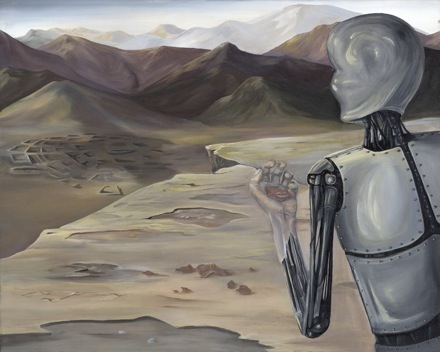Copyright © 2005 Abraham Studios
Send mail to abrahamart@gmail.com with questions or comments about this site.








Copyright © 2005 Abraham Studios
Send mail to abrahamart@gmail.com with questions or comments about this site.
The Automaton vs. The Existentialist
Nevada-inspired
30 x 24"
acrylic on canvas
Terbush Gallery, Sedona, AZ
$1300
It has become clear that a significant part of our intellect is derived from pictures and stories of other people’s experiences. Our minds are programmed before we are able to speak, making us nothing more than products of our environment. Here in New Mexico, I undergo a personal transformation.
With four months of traveling behind us, New Mexico becomes our twelfth state to visit. It is March, and we cross into the Northeast corner of the state during a blinding snowstorm. Unplowed pavement forces us to pull off the road. We watch the blizzard evolve from windows within a small gas station (which conveniently has a laundry-mat attached to it). As the show finally subsides, we get back in the car to look for a place to sleep and hope once again that we don’t freeze in the night.
The morning sun shines upon us as we head to Capulin Volcano. We ping-pong through the state: traveling from Aztec to Chaco, Bandelier to Gila, and everywhere in between. Almost every day is spent exploring ruins from 700-1000 years old. As I watch brilliant white sand dunes turn pink with the sun set, it becomes evident that only a small part of the land is anything like I had imagined. With this realization I discover that I have had a completely skewed vision of the American landscape. History and geography have never been so tangible, nor interested me the way they do now.
I feel the past twenty-three years of my life were spent as an automaton, and only now am I becoming human. I am being reprogrammed and flesh melts these metal limbs as I overlook an ancient civilization. I think of a time where individuals traveled without rubber and steel to separate them from the ground. At one time, living was actually about sustaining life. Bare feet embraced the earth, and naked hands clawed into the dirt. Every activity relied on the collaboration of a community, in order for the tribe to survive.
A shadow crosses this mysterious land. I look up to see a crow flying overhead, and wonder if it is carrying away those souls that once occupied the earth. When the Anasazi disappeared, they left only their earthen construction behind. After generations of meticulous design, why would they leave? Was it insufficient resources that sent them searching, a Spanish invasion that made them flee? Or did they simply set out to seek a better life after evolving into the insatiable beings that we are today? As I stand on this cliff, I struggle to realize that I may never understand the people who built these extraordinary structures. However it becomes more unsettling to think that as a society, we fail to relate to one another everyday. Are we all spending our days building and gathering in vain?










